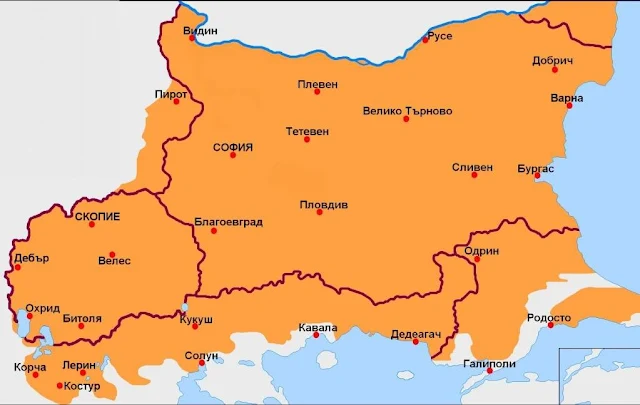Bulgarian dialects (гòвори) are part of the South Slavic dialect continuum, linked with Serbian to the west and bordering Albanian, Greek and Turkish to the south, and Romanian to the north. All Slavic dialects spoken in the geographical regions of Macedonia, Thrace, Moesia, and Dobrudzha are dialects of the Bulgarian language. [1] [2] [3] [4] [5] [6] [7] [8] [9] [10] [11]
9 May 2013
8 May 2013
Borders of Bulgarian language
The distribution of Slavic languages may be visualized by a chain of circles that cross and intermingle so that many transitive dialects arise. In this Slavic chain, Bulgarian is the south-most link which is located between Serbian and Russian. Because the interactions between Bulgarian and Serbian, on one hand, and between Bulgarian and Russian, on the other, are not equivalent, the similarities of Bulgarian to Russian and Serbian are not the same. While Bulgarians and Serbs lived very close to each other for a very long time on a long borderline, the connection between Bulgarian and Russian took place on a narrow strip along Dobrudzha which was populated with other foreign peoples and was interrupted by the wide and scarcely populated Danube delta. The relatively large similarity between Bulgarian and Russian can be explained by the former Russian-Bulgarian neighbourship in the old homeland of Bulgars and Bulgarian Slavs and with subsequent loans between Bulgarian and Russian.
History of Bulgarian language
7 May 2013
Report from Visoka
Дописка от село Висока
Дописка от село Висока, днес Оса, Солунско, вестник „Съветник“, № 29, 7 октомври 1863. Написано на солунски диалект. Правописът е запазен.
Railway construction in Macedonia during the Bulgarian Unification (1941-1944)
by Dr. Angel Dzhonev, Ph.D

Work along Kumanovo-Gyueshevo track
Bulgaria joined the Tripartite Pact on March 1, 1941. The rapid defeat of Yugoslavia and Greece by the Wehrmacht forces in April 1941 was followed by the provisional annexation to the Bulgarian Tsardom of territories in Western Thrace, south-eastern Macedonia, the islands of Thassos and Samothrace, collectively called the Aegean, Vardar Macedonia, Kosovo and Morava region together with the Western Borderlands, with a total area of 39,765.6 square kilometers.
Morava Bulgarians in Serbian literature
material evidenceof its whole spiritual life. The realistic Serbian literature at the turn of 19th c. documented the Bulgarian character of the population along Morava and Nišava.



